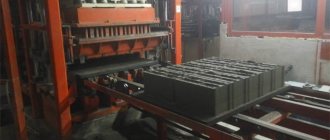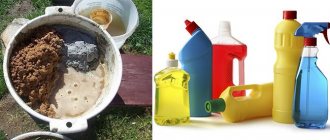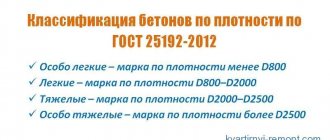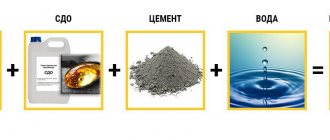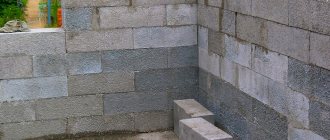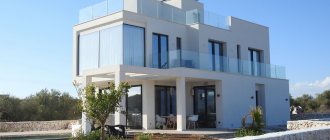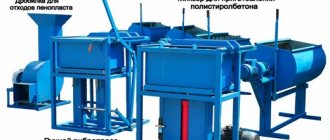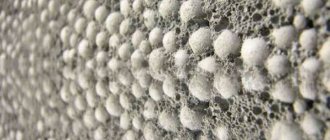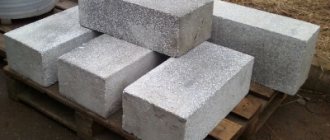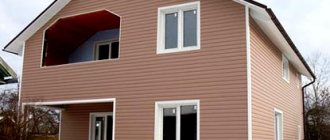The first question that comes to mind after deciding to build your house is what material to choose for construction, so that the process goes quickly and the result is of good quality. Experts recommend paying attention to this type of building material, such as polystyrene concrete.
House made of polystyrene concrete blocks Source medium.com
What is polystyrene concrete
Every year the structure of the construction market develops, and along with it the range of products increases, and innovative materials for construction appear. One of the latest innovations for the construction of buildings is polystyrene concrete blocks.
Essentially, polystyrene concrete consists of cement mortar with the addition of polystyrene foam granules (well-known foam balls).
However, it is almost impossible to mix polystyrene foam with concrete - the granules are lighter than water and float to the surface without forming a homogeneous solution. The solution to this problem is hidden in the use of special additives: foaming agents and modifiers:
- Foaming agents can be natural or synthetic. In construction, a natural foaming agent such as saponified wood resin (tree resin that has undergone special treatment with alkali) is often used.
- Modifiers are substances that can be used to change the technical characteristics of a cement mortar (to make it stronger, more plastic or frost-resistant). To create polystyrene concrete, it is necessary to increase the plasticity of the cement mortar, therefore the modifiers used in its production are also called plasticizers. In this case, liquid soap or slaked lime, as well as special industrial chemicals, are used as plasticizers.
Composition of a polystyrene concrete block Source kamtehnopark.ru
At home, you can make polystyrene concrete with your own hands, from certain components in accordance with the proportions, or purchase polystyrene concrete in bags, in the form of a dry mixture for preparing a solution according to the instructions. But for the blocks to be ready for use, they must lie for at least 2 weeks.
If you don’t have time to make it yourself, then it’s better to buy polystyrene concrete blocks in a specialized store.
Features of floor installation
Polystyrene concrete is characterized by strength. When pressed, cracks and chips do not appear. Based on this property, the material is often used for flooring. It allows you to keep heat inside the room. If the surface breaks, it can be repaired. Possibility of using the material:
- Buying ready-made mixture in bags.
- Mixing components yourself.
Polystyrene concrete is also used as insulation. The surface has the following advantages:
- Increasing the strength of the roof and preventing corrosion.
- There is no need for a thick screed. The load is evenly distributed over the surface.
- There are no seams on the plane.
- Arrangement of a roof that is at an angle of up to 30 degrees.
- There is no deformation or leakage.
- Durable and environmentally friendly material.
Pros and cons of the material
Before you buy polystyrene concrete blocks, you need to learn about the positive and negative qualities of the material.
The process of building a house from polystyrene concrete blocks Source stst.kz
Advantages of polystyrene concrete
The positive properties of polystyrene concrete raw materials include the following characteristics:
- environmental Safety;
- low flammability;
- easy processing (you can give the block the desired shape with a regular saw);
- possibility of self-production;
- a light weight;
- withstands sudden changes in air temperature (remains unchanged at temperatures above +70 C and below -55 C);
- sufficient strength (if you screw a screw or bolt into polystyrene concrete, it can easily support hanging furniture);
- high degree of resistance to moisture;
- polystyrene concrete does not need insulation;
- The service life of the building, if properly manufactured, is 100 years.
Decorating a house from polystyrene concrete blocks Source pinterest.at
Disadvantages of polystyrene concrete blocks
Since there is no ideal building material, polystyrene concrete has its disadvantages:
- It does not allow steam to pass through, so you need to ensure good ventilation in the building.
- After the construction of the building, you need to immediately begin finishing it.
- Under the influence of high temperature, a void is formed inside the block due to the fact that the granules melt.
Another disadvantage is the high cost of the finished material , but the service life justifies it.
See also: Catalog of companies that specialize in the construction of turnkey country houses.
Specifications
Monolithic polystyrene concrete, reviews of which are mostly positive, is characterized by the following properties:
- The structure of the material does not suffer from open fire.
- Retains properties at temperatures from -60 to 70 degrees.
- Maintains comfortable indoor conditions.
- Reduces humidity and regulates it to an optimal level.
- High tensile strength.
- Does not interfere with natural air circulation.
- Frost resistance.
- Consists of completely safe and hygienic materials.
- Does not rot and prevent rodents from growing on the surface.
- Ability to conduct heat.
- Life time.
- Noise isolation.
- Density.
- Heat release.
- Not subject to shrinkage.
- High strength.
- The material base will withstand heavy equipment. Additionally, you will need to perform a screed.
Application of polystyrene concrete
Polystyrene concrete is used for the following types of construction work:
- floor insulation;
- creating floor coverings;
- construction of load-bearing walls and partitions;
- creating sound insulation in the room;
- installation of interfloor ceilings.
House made of polystyrene concrete with brick exterior Source roomester.ru
Features of the composition
Monolith made of polystyrene concrete - a cellular surface with a density from 150 to 600 kg/m3. Thermal insulation material is obtained by mixing the components:
- Portland cement.
- Polystyrene foam granules. They are obtained by foaming.
- Portland slag cement.
- Water.
The purpose of adding modifying components to the composition:
- Prevent cracking.
- Increased plasticity.
- Adjustment of complete drying time.
- Acceleration of surface hardening.
- Air removal.
How to determine the quality of purchased raw materials
If you have chosen polystyrene concrete to build a building, when purchasing it you need to pay attention to the following criteria:
- the product must have a quality certificate and documents with information about the composition of the product;
- blocks must be free of voids;
- polystyrene granules in blocks must be the same size;
- there should be a large number of granules in the block, which is clearly visible on its cut.
House made of polystyrene concrete blocks under construction Source twoidvor.com
Manufacturing process
Monolithic construction made of polystyrene concrete is popular today. The composition increases strength due to a special paste. It consists of particles that have many similarities with foamed polystyrene.
A large-porous structure is obtained by covering the granules with a layer of cement glue. The process is complex, because the filler is characterized by a smooth surface. The problem was solved using special equipment. Additionally, chemical components are added to the composition.
The dosage of aggregates directly depends on the volume and properties of the surface. On the device you can set the exact pore size and mass of the solution. Several technologies are used that make it possible to obtain the necessary porosity of the structure.
House construction technology
Building a house from polystyrene concrete blocks is not a long process at all. The main thing is to know the technology and adhere to the sequence of stages.
The first step is to decide on the layout of the house and draw up a project. After preparing the plan, you can start working:
- The first step of construction will be laying the foundation . Polystyrene concrete is a lightweight material, so a lightweight foundation is sufficient for the building.
- Roofing felt is used to waterproof the floor .
- is laid out with stone .
- All necessary communications are laid : heating, water supply, sewerage.
- Laying the walls of a building begins from the corners. The rows are laid out in the form of a chessboard. The necessary openings are not built up; wooden lintels are installed above them and partitions are built. A special glue is used to connect the blocks together. In the case of building a two-story house, the walls are subject to reinforcement for greater strength and to prevent cracks.
- Roof installation . In a house built from polystyrene concrete blocks, bitumen shingles are used for roofing.
Bituminous shingles are roofing materials based on fiberglass or organic cellulose. A special binder, bitumen, is applied on top of the base, and mineral chips (finely crushed minerals) are placed on top of it. The crumb is designed to protect the roof from precipitation and sunlight. Depending on the type of roof, either fine sand (typical of traditional tiles) or special self-adhesive substances (they are used to create self-adhesive roofing material) are applied under the cellulose or fiberglass base, depending on the type of roofing.
A blind area is a strip of continuous covering (most often concrete) running along the ground around a building and protecting the foundation of the building from the destructive effects of moisture.
House made of polystyrene concrete with external finishing Source kamloopsmatters.com
Comparison with other materials
The technological properties of polystyrene concrete are better than those of many other building materials. Being a new material based on cement mortar, it is a leader even among similar products.
Experts, after comparing construction materials according to various parameters, provided the following differences between polystyrene concrete and foam concrete:
- Foam concrete is slightly lower in price, but its ability to absorb large amounts of moisture negatively affects the service life of the constructed building. In this case, polystyrene concrete blocks are more profitable.
- Polystyrene concrete is stronger than foam concrete; in comparison, foam concrete is twice as heavy, but it is very fragile and is often destroyed during transportation.
- The thermal conductivity of polystyrene concrete raw materials is 5 times less, and its resistance to sub-zero temperatures is 3 times higher than that of foam concrete.
These comparisons prove the fact that polystyrene concrete is a good material for building a house. It is durable and will require repair work less often than other buildings. Builders call polystyrene concrete a new generation material; it has many advantages, and at the same time is very easy to manufacture.
